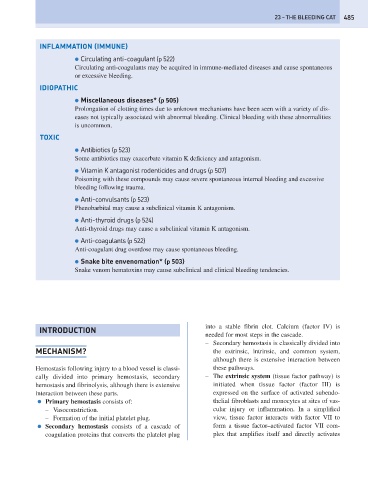Page 493 - Problem-Based Feline Medicine
P. 493
23 – THE BLEEDING CAT 485
INFLAMMATION (IMMUNE)
● Circulating anti-coagulant (p 522)
Circulating anti-coagulants may be acquired in immune-mediated diseases and cause spontaneous
or excessive bleeding.
IDIOPATHIC
● Miscellaneous diseases* (p 505)
Prolongation of clotting times due to unknown mechanisms have been seen with a variety of dis-
eases not typically associated with abnormal bleeding. Clinical bleeding with these abnormalities
is uncommon.
TOXIC
● Antibiotics (p 523)
Some antibiotics may exacerbate vitamin K deficiency and antagonism.
● Vitamin K antagonist rodenticides and drugs (p 507)
Poisoning with these compounds may cause severe spontaneous internal bleeding and excessive
bleeding following trauma.
● Anti-convulsants (p 523)
Phenobarbital may cause a subclinical vitamin K antagonism.
● Anti-thyroid drugs (p 524)
Anti-thyroid drugs may cause a subclinical vitamin K antagonism.
● Anti-coagulants (p 522)
Anti-coagulant drug overdose may cause spontaneous bleeding.
● Snake bite envenomation* (p 503)
Snake venom hematoxins may cause subclinical and clinical bleeding tendencies.
into a stable fibrin clot. Calcium (factor IV) is
INTRODUCTION
needed for most steps in the cascade.
– Secondary hemostasis is classically divided into
MECHANISM? the extrinsic, intrinsic, and common system,
although there is extensive interaction between
Hemostasis following injury to a blood vessel is classi- these pathways.
cally divided into primary hemostasis, secondary – The extrinsic system (tissue factor pathway) is
hemostasis and fibrinolysis, although there is extensive initiated when tissue factor (factor III) is
interaction between these parts. expressed on the surface of activated subendo-
● Primary hemostasis consists of: thelial fibroblasts and monocytes at sites of vas-
– Vasoconstriction. cular injury or inflammation. In a simplified
– Formation of the initial platelet plug. view, tissue factor interacts with factor VII to
● Secondary hemostasis consists of a cascade of form a tissue factor–activated factor VII com-
coagulation proteins that converts the platelet plug plex that amplifies itself and directly activates

